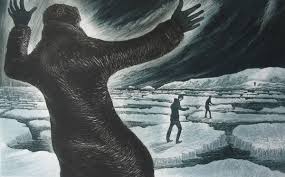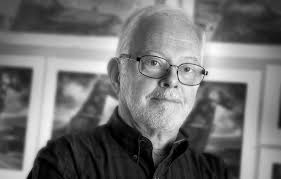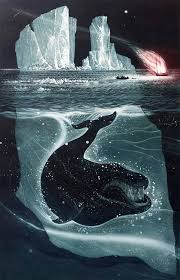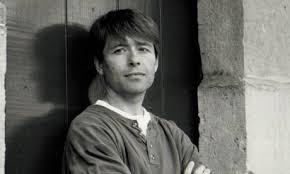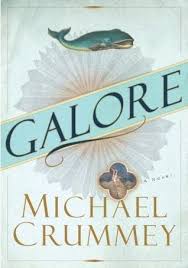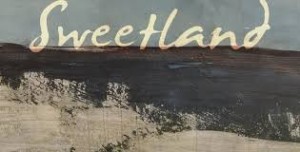I’m fascinated by the rich culture of Newfoundland. I love its music, its literature (poetry and prose as well as drama) and its visual arts. I have yet to visit Canada’s easternmost province; however, I yearn to cast fur and feather at homebound Atlantic salmon, revered as the King of Fish, on one of its beautiful rivers.
David French’s Salt-water moon, the third book — and to my mind the best — of his Mercer family saga, is one of my favourite Canadian plays. I have seen and reviewed it three times and would enjoy seeing it another three times, or more.
I have long enjoyed Newfoundland’s traditional music and the roots music it inspired — from the late Ron Hynes, one of Canada’s great songwriters, through Pamela Morgan and Figgy Duff, to Great Big Sea. I interviewed GBS’s frontman Alan Doyle in 1995, shortly after the release of the band’s sophomore album and big label debut Up. He gently chided me for mispronouncing Newfoundland. ‘It rhymes with understand,’ he instructed.
I was introduced to Newfoundland writers or fiction set in Newfoundland in the 1970s when I was an undergraduate with an intense passion for Canadian literature, majoring in English at Trent University. National epic poet E.J. Pratt was a CanLit giant at the time. Is he read much these days? He should be. Does anyone remember Peter Such’s Riverrun, a brilliant novel set in Newfoundland in the early 1800’s depicting the last 25 years of the Beothuk’s existence?)
The writers I have come to admire most include Wayne Johnston (especially his masterwork The Colony of Unrequited Dreams and creative memoir Baltimore’s Mansion) and Michael Crummey (both fiction and poetry), in addition to Joan Clark, Patrick Kavanagh (at least his Newfoundland myth of origin Gaff Topsails), Kevin Major, Lisa Moore, Bernice Morgan, Donna Morrissey, John Steffler and Michael Winter.
I have long admired the high realism of Christopher Pratt, who I fondly remember conducting a slide-lecture at the Dundas School of Art somewhere around 1985, in addition to master printmaker David Blackwood, whose visual recollections of his Newfoundland youth are soaked in sociology and psychology, history and myth.
In celebration of Newfoundland’s culture I would like to return to a quartet of reviews I wrote for the Waterloo Region Record in my capacity as an arts reporter for three decades. Featured are a couple of reviews of novels by Michael Crummey and book and exhibition reviews devoted to David Blackwood. I think the observations expressed in the reviews are as relevant today as when I wrote them. I link the printmaker and the poet/novelist here because Crummey contributes a personal essay to Black Ice: David Blackwood’s Prints of Newfoundland, the most recent book on Blackwood.
Newfoundland Seen Through a Visionary’s Eyes
Although he maintains a studio in Newfoundland, David Blackwood has lived in Ontario since 1959 when he won a scholarship to the Ontario College of Art, where he learned the etching process that eventually brought him recognition as one of Canada’s premier printmakers.
Blackwood came from a long line of seafaring men. Although he preferred pencil and crayon to net and tiller from an early age, the sea was in his blood every bit as much as it was in the blood of his father, grandfather and great-grandfather. His years in Ontario have done little to blunt his memories of growing up in the small, secluded fishing outport of Wesleyville, nestled precariously on the northeastern inlet of Bonavista Bay.
David Blackwood: Master Printmaker (Douglas and McIntyre) celebrates Blackwood’s immediately recognizable prints. It reproduces 141 etchings, completed between 1963 and 2000, providing a representative sampling of his subject, technique and style. Some constitute Blackwood’s best-known images.
The reproductions effectively convey the raw and handsome power of Blackwood’s prints, which are limited to black and white, augmented with Persian blue, burnt sienna and burnt umber. The narrative and genre images are autobiographical in that they depict the Newfoundland of his childhood. I like to think of them as memory narratives expressed through line, shape and texture instead of words.
As documentation of a lost way of life, they are sociological and historical. The prints are representational; however, they are not realistic in a conventional sense. Because the characters, events and way of life portrayed have vanished, they appear in the prints as surrealistic vestiges of dreams and nightmares. This endows the prints with a haunting sense of mystery which is not so much nostalgic as elegiac.
Blackwood is a visionary artist. He doesn’t chronicle a lost way of life so much as present dramatically people who embody the eternal rhythm of life lived in an unforgiving environment where sea bashes rock unceasingly and forever.
A traditional biographical essay and critical assessment of the artist would have made David Blackwood: Master Printmaker a valuable addition to the many books devoted to Canadian art. However, William Gough’s text kicks things up another notch. A fellow Newfoundlander, Gough is an accomplished writer. Consequently, his text offers a complementary view of the Newfoundland celebrated in Blackwood’s prints. His text doesn’t so much explain and evaluate as provide a poetic context for the world Blackwood’s prints preserve. It’s an altogether evocative marriage of text and image.
Also included is a chapter devoted to Blackwood’s most recent series of 10 working proofs for Heber Fifield as a Great Mummer. The series gives readers a chance to accompany the artist as he goes through the creative process.
Acclaimed American writer Annie Proulx, who has done as much as anyone to herald an artistic renaissance in Newfoundland thanks to her brilliant novel The Shipping News, contributes a short appreciation. As she rightly points out, sometimes a great artist appears in the nick of time to record a time and a place on the cusp of irreversible change.
David Blackwood is such an artist. It’s as though he has answered a reverential calling to remember with eye and hand, so that we all might glimpse that which has vanished, but has not been forgotten.
Mythic Thrust: Dramatic Struggle Between Humanity & Nature
David Blackwood has lived in Ontario since 1959 when he won a scholarship to attend the Ontario College of Art, but he has never left his native Newfoundland in terms of his heart, his mind, his imagination — and his art.
Acknowledged as one of Canada’s most accomplished printmakers, his distinctive etchings are immediately identifiable. Beginning with his student work, Blackwood developed a unique visual vocabulary that has grown in weight and substance without altering in essentials. Similarly, its haunting power has persisted unabated.
The David Blackwood Survey Exhibition was mounted in 1999 to celebrate the opening of the David Blackwood Gallery, at the University of Toronto’s Erindale College, where Blackwood was artist-in-residence for many years. Curated by Nancy Hazelgrove, the national touring exhibition on view at Cambridge Library and Gallery consists of 27 etchings spanning the decade between 1980 and 1990.
Blackwood’s narrative prints are almost wholly autobiographical. They depict and document the Newfoundland that existed during Blackwood’s youth and formative years in the 1940s and 1950s, when he lived in the small, secluded fishing outport of Wesleyville, tucked along a northeastern inlet of Bonavista Bay.
The Newfoundland of Blackwood’s youth has all but vanished so that, while his work is both sociological and psychological, it also is historical. Blackwood’s Newfoundland is Newfoundland Lost — equal parts memory, dream and nightmare. Consequently, his etchings are not so much nostalgic as elegiac. His is a visionary art, as surrealistic as it is realistic.
Although the prints chronicle life as once lived in the Newfoundland outports, they are also highly symbolic. In depicting a harsh life of heroic struggle pitted against the natural forces of rock, ocean and climate more cruel than malign, Blackwood’s prints are mythic in thrust.
The natural world is immediate and everpresent; threatening, if not overtly hostile and dangerous, despite moments of delicacy and fragility as represented by a butterfly alight a tiny flower.
Blackwood’s prints, however, capture and express more than the landscape, seascape, climate, weather, lifestyle, rituals, personality and texture of Newfoundland. They convey a haunting sense of mystery, which seems both very old and urgently insistent — a blend of the superstitious and the supranatural. A sense of the afterlife is powerfully evoked.
Blackwood’s father was a sea captain and the ocean — with its whales and icebergs — is present in all but a few of the prints, either as subject or as backdrop. These are psychological and spiritual forces as well as forces of nature, which inspire awe and fear in human endeavour, forever humbled yet never vanquished.
Blackwood is a superb draftsman and his colours, while limited to Persian blue and black, burnt sienna and burnt umber, are rich and handsome. Few Canadian artists are as deeply and inextricably linked to a particular time and place. Yet, the struggle between humanity and nature dramatized through his highly personal and individual art is universal in scope.
Glorious Galore
Had James Joyce been born and raised in Newfoundland, he might have written Galore, a glorious novel written by Michael Crummey.
The St. John’s writer is the author of three books of poetry and a collection of short fiction. He’s no stranger to literary accolades. His debut novel, River Thieves, was a Giller Prize finalist, and his sophomore novel, Wreckage, was a national bestseller and a Rogers Writers’ Trust finalist. He also won the Bronwen Wallace poetry prize and was a Journey Prize finalist. So it comes as no surprise that Galore (Doubleday Canada) is a finalist for the Governor General’s Award.
Crummey has always been a novelist with poet’s eye. However, Galore elevates the bar to a level where naturalism (history, mystery, epic, romance, elegy) blends with the fantastical (legend, tall tale, fable, superstition, dream, nightmare, vision) driven by a mythic impulse to create anew.
Rich in the textured nuances of time, place and people, if the novel has a reason for being it would be language in all its myriad splendour. Even if readers get lost in the intricacies of story and character — as readers might — they can coast high and wide on the kite tale of language.
Galore tells the multi-generational, communal story of the isolated outport of Paradise Deep and it’s people, including those from afar who turn up in the belly of a whale. The novel’s fulcrum is two families — the Sellers and the Divines — that massage ancient grievances that involve affairs of the heart. The novel is intricately woven as the threads of past and present overlay and intersect. Even the characters’ names are wonderful — beginning with Devine’s Widow and King-Me Sellers. Others echo Biblical names — Judah, Lazarus, Absalom, Hannah, Abel and Esther.
At bottom, Galore is about the enduring power of story to answer the fundamental questions — from where do we come? what is family? where is home? what is love? what does it all mean?
It casts an affectionate light on an old, vanished world, whose remnants can still be detected in Newfoundland by those with the heart and the imagination to do the excavation. But the days are numbered for even these gifted artists, Crummey among them.
W.O Mitchell famously asserted that the Prairies bred poets. With writers such as Michael Crummey, it can be said that Newfoundland breeds mythmakers who carry forward the enduring oral tradition that extends back to the island’s earliest days — and before.
How Sweet Sweetland Is
Michael Crummey is one in a bouquet of accomplished writers to bloom in Newfoundland over the past quarter century.
Of Wayne Johnston, Michael and Kathleen Winter, Lisa Moore and Donna Morrissey, Crummey is the one with his fingers on the mythic pulse of a place where mythology blends with history, legend, folklore, superstition, religion and art (oral, written, visual and musical). This is a place where the landscape of geography, climate, flora, fauna and weather shapes the interior-scape of mind, heart and soul.
In addition to his four books of poetry and short story collection, Sweetland (Doubleday Canada) is Crummey’s fourth novel, following the Giller finalist River Thieves, Rogers Writers’ Trust Fiction finalist The Wreckage and Governor General’s finalist Galore. Expect his latest novel to dock in the harbour of prominent literary awards lists.
Sweetland is three things: the book’s title, the protagonist’s surname and the fictional island that provides the setting and where most of the action unfolds.
Name and place are both inextricably intertwined with identity. When asked by a government clerk how long his people have been on the island, Moses Louis Sweetland replies, ‘time before time.’
Former cod fisherman, retired lighthouse keeper and disfigured virgin-bachelor, Moses is the last in an ancestral line stretching back to the settlers who first landed on the island off Newfoundland’s southern coast. He also is last to leave when he concocts a secret scheme to remain on the island of his forefathers after all the other members of the isolated, insular community accept a relocation offer from the government.
The first half of the novel follows Moses as he pits himself against neighbours anxious to accept the all-or-nothing offer to abandon the island. The last hold-out, Moses alienates himself from the close-knit community as neighbours try scaring him into accepting the offer by delivering threatening notes and hanging mutilated rabbit heads on the door of his fishing shed before burning it to the ground.
The second half of the novel traces the consequences of the 69-year-old’s decision to stay behind — a mangy dog his only companion, along with ghosts from the past who haunt his fevered dreams as he struggles against inhospitable elements.
Crummey spends a lot of time memorializing such skills as snaring rabbits and preparing them for the pot, recognizing that such mundane rituals of survival are on the cusp of extinction. Similarly he paints a gallery of affectionate portraits of Moses’ neighbours.
First and foremost is Jesse, a developmentally challenged 12-year-old who talks to ‘imaginary friends’ including Moses’ brother Hollis, who drowned at the age of 18 while the two were fishing. Moses describes his grand-nephew as ‘a well you would never see the bottom of, that might swallow you whole if you weren’t careful.’
Clara is Jesse’s single mother, the daughter of Moses’ sister Ruthie who is married to Pilgrim, a much-older, blind man who sees into the heart of things and is revered as the island’s best moonshine bootlegger. Duke, a barber who shakes so bad he has never trimmed a strand of hair, spends his time sweeping the shop and playing a never-ending game of chess with Moses, the friend he accompanied to Ontario to work as young men with unfortunate consequences.
Loveless is the island’s second-to-last hold-out, a man lost to the world since his illiterate sister Sara died. The ‘Golden’ Priddles, Keith and Barry, are a pair of twins born 10 months apart who trudge through life crotch-deep in trouble.
Crummey punctuates the present narrative with an incident from the past involving a boatload of Sri Lankan refugees who, cast adrift at sea, seek refuge on Sweetland, marking the only intrusion of the wider world on the island with the exception of Hockey Night in Canada, all-terrain vehicles, the Internet, cell phones and illicit drugs.
Oscillating between past and present, Crummey tells his story at a slow, leisurely pace, dropping narrative details like breadcrumbs along the path of a serpentine tale, a remembrance of things past told around the woodstove on a long winter’s night.
Sweetland is symbolic of the Newfound diaspora that has been a sad fact of life since 1949 when the island joined Canada. In tone, mood and atmosphere, the novel recalls Newfoundland-born David Blackwood’s ghostly etchings that depict so powerfully and so evocatively a vanishing way of life. But more important, Sweetland is its own creation — one that immerses readers in a lost, lovingly remembered and attentively rendered world, recalling the unrecoverable past, a tale of myth and magic, of memory and loss.
Below author Michael Crummey explores the mythology and realities of life in Newfoundland embodied and reflected Galore:
Below printmaker David Blackwood in conversation with Seamus O’Regan 2016:


